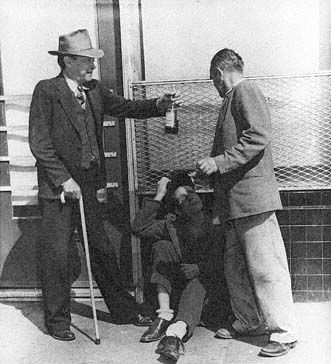Making Tenants Invisible
As with the SFRA's applications of blight and nonbuilding, the actions of other hotel-closing agencies were not (in their own minds) aiming the wrecking ball at the homes of the poor but "eliminating dead tissue," "applying the scalpel," "clearing away the mistakes of the past," and building "an attractive new city." About a Norfolk, Virginia, hotel district, one planning journal editor reported in 1961 that "progress had reached the demolition stage." Local agents crowed that they had "reduced to rubble . . . scores of flophouses not renowned for adding luster to their city's good name."[31]
Because officials did not consider hotels to be permanent housing, during the official massive downtown clearances from 1950 to 1970, people living in hotels were not tallied as residents. Hence, when a

Figure 9.12
Helping to make skid row residents look bad, 1956. This picture
of a bottle club in the South of Market was carefully posed
by a San Francisco newspaper photographer. Fostering
such stereotypes lessened concern about SRO demolition.
city demolished an SRO building, "no one" had been moved, and no dwelling units were lost in the official counts and newspaper reports (fig. 9.12). In reality, of course, hundreds of thousands of SRO people and homes were being removed. Deliberate ignorance had become a cultural blind spot that made hotel residents invisible both to officials and to the public. A 1970 planning study in San Diego found only 100 people living in the city's large single workers' district, which was being considered for demolition. Local hotel housing advocates protested. A second count in 1975 found 499 people in the same district; after another protest, a third count found 1,000 hotel people still living in the district—and this after several hotels had closed because of the official pressure. In some cities, the people removed were difficult residents: bums, psychotics, or other marginal people. But the vast majority were not marginal. By making them invisible, experts made the rough handling of such people easier.[32]
Relocation costs gave city officials another reason to make hotel residents invisible. The 1961 Housing Act provided up to $200 for a family displaced by renewal but gave no guidelines and granted no federal funding for single individuals. To fill that gap in the law, the Urban
Renewal Administration in Washington authorized local authorities to pay each single SRO person a relocation fee of $5, approximately cab fare out of the neighborhood. "Transients," those who had lived fewer than ninety days at a hotel, did not even qualify for the $5, although many local agencies paid the token relocation fee to any SRO tenant who applied.[33]
In San Francisco's redevelopment of the South of Market, politicians and downtown leaders deemed a large clearance was necessary for what eventually has become the huge Moscone Convention Center and its adjacent Yerba Buena Gardens. In the blocks to be cleared during the 1960s, 91 percent of the households were single, and most were white; 97 percent lived in hotels. A surprising 41 percent of the 240 families in the renewal area also lived in hotels. Later studies estimated that about 40,000 hotel rooms were destroyed, although city officials kept no tally.
Initially in areas like the Western Addition and South of Market, the opposition of hotel residents was neither strong nor organized. Instead of fighting a seemingly impossible battle, tenants took their $5 relocation fee and moved. To their credit, the staff in many urban renewal agencies attempted to give SRO tenants help in finding a new home; in some cases, the appointed social workers made repeated visits and multiple notices. The SRO residents, tending to be fiercely independent and suspicious of authorities, usually had ample reason to mistrust overtures from urban renewal agents. In any case, up until the early 1960s the vast majority of the tenants moved on their own, without help. Long after the supply of inexpensive SRO housing had reached a critical stage, these tenants still thought they could find a new place.[34]
In the late 1960s, hotel tenants met increasing frustration in finding rooms. The losses in rooms had far outpaced the losses in clients. No national figures exist for the number of SRO hotel rooms destroyed before 1970; estimates usually refer to "millions" of rooms closed, converted, or torn down in major U.S. cities. Including the hotels closed in small towns and medium-sized cities would double the number of units lost.[35] Alarmed by the simmering political and health implications of relocation and the declining quality of life in inexpensive hotels, a few pioneering planners, social workers, public health officials, and journalists recognized the beginning of an SRO crisis.[36] During the 1960s, this new corps of SRO advocates began to chip away at the unfair
stereotypes about hotel life. Their work coincided with a growing professional and public disillusionment with downtown renewal. The publication of books such as The Death and Life of Great American Cities in 1961, The Urban Villagers in 1962, and The Federal Bulldozer in 1964 had galvanized critiques of urban renewal processes and goals.[37] Among housing officials and planners, the time was ready for a more widespread change of heart about hotel life. Unfortunately, for many hotel residents, this revised view would be too late.